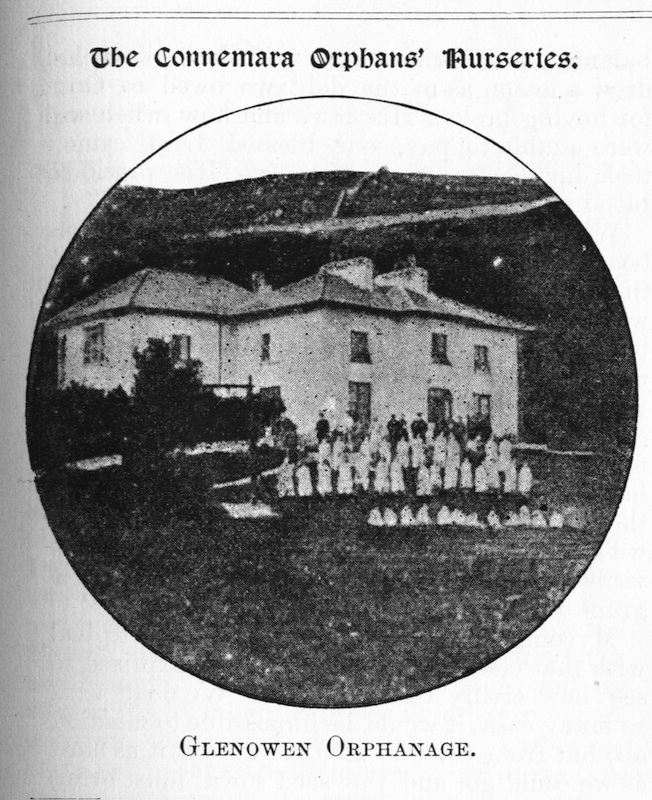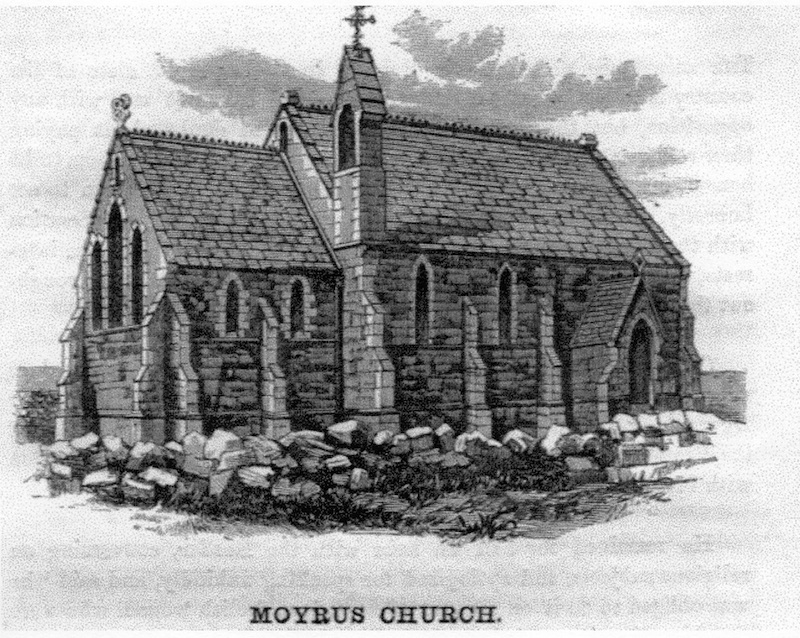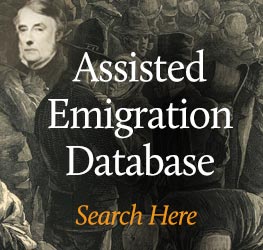The Famine years were particularly harsh all over the west of Ireland, and especially in the Connemara region whose population of tenant farmers and labourers depended almost entirely on the lumper potato. Thousands died when the potato crop failed in the summer of 1845 and failed again over the following three years. Those who managed to survive were weakened by years of hunger and disease and found it difficult to restart their lives as their work tools, farm implements and furniture had been sold to raise money for food. This was the environment into which the Irish Church Missions stepped when it began its proselytising work in Clifden in early 1848. Its arrival, with plentiful supplies of food and clothes, must have seemed like a godsend to the starving poor of Connemara.
The Irish Church Missions was established by Revd Alexander Dallas, the Church of England rector of Wonston in Hampshire and had been active at Castlekerke, near Oughterard since 1846. Its ambition was to convert the Roman Catholic population of Ireland to scriptural Protestantism and it was handsomely funded by the Protestant population of Great Britain. The Irish poor who attended the Irish Church Missions schools and churches of received clothes and food in addition to educational and religious services and, with the west of Ireland in the midst of a dreadful famine, it is unsurprising that the poor of Connemara eagerly flocked to the Protestant Irish Church Missions. Within a short time the mission could correct claim a very large number of converts or ‘jumpers’ as they were known. [It is thought that the term Jumpers comes from the Irish expression d’iompaigh siad – they turned.]
The mission’s attraction was undoubtedly its provision of food but it chose to interpret the vast attendances at its schools and services as unquestionable proof that the Irish poor were ripe for conversion and, in January 1848, it extended its operations westwards to cover the whole of Connemara. When the mission undertook work in a locality, it established schools where children were taught during the day and adults at night, and where divine service was held until purpose-built mission churches were built. Schools were clustered into mission districts under the control of a missionary clergyman and scripture readers went out through the countryside, visiting houses, reading scriptures and leaving a parcel of food as they left. Unsurprisingly, the famine-stricken inhabitants of Connemara urged them to return again soon and pleaded an interest in the scriptures.
A very large work-force of teachers, scripture readers and clergymen was maintained by the mission. In 1852, it operated thirty-seven schools in Connemara where it maintained nine clergymen, fifty-seven scripture-readers, fifty-one school-teachers, paid out of donations to the mission, which amounted to £12,688 that year. Its English supporters were assured of its success, convinced by an endless output of reports of huge attendances at its schools and services. At this time, it seemed that a successful nationwide campaign was feasible. Bolstered with the prospect of success, funds flowed into the mission’s coffers; by 1854 its annual income had grown to £40,089 and in time, the mission would establish sixty-four mission schools west of the line from Spiddal to Leenane. It also established residential homes for destitute children at Clifden (Glenowen for girls and Ballyconree for boys), at Spiddal (Connemara Orphans Nursery) and later at Leenane (Aasleagh Children’s Home).
Clifden became a popular destination for English supporters, eager to view the progress of the missions. Its hotels were filled to overflowing in August 1852 when 127 English visitors arrived to witness the consecration of the first mission church at Moyard Bridge (Ballinakill), many of these were English clergymen, secretaries of branches of the Irish Church Missions which had been established in parishes throughout England. These men were greatly impressed by what they saw, one reported that the area which had been essentially Catholic five years earlier had become ‘characteristically convert and Protestant … with a flock gathered and folded by pastors of the United Church’.
The mission answered the two most pressing needs of the poor of Connemara: food and education. Although a government-funded system of education was in place since 1831, the Roman Catholic archbishop of Tuam, John MacHale, forbade the establishment of state-sponsored schools within his diocese and, as the population of Connemara was too poor to pay for privately funded schools, the majority of Connemara people were deprived of an education. As emigration to America was well established by then, the parents of Connemara were keenly aware of the need to equip their children with the basics of reading and writing and a knowledge of English and eagerly sent their children to mission schools to correct this deficit. Adults, who had been reared without schooling, attended the night schools so that they also might learn to read and write.
Of course, the mission provided more than food and education; it also provided scriptural instruction and instilled a contempt for Roman Catholicism in its pupils. It had, after all, been founded with the expressed purpose of converting the Catholic population of Ireland to scriptural Protestantism or, as contemporary publications explained, it hoped to rescue Irish Catholics from the ‘errors of Rome’. While its provision of food and education were laudable, the methods employed to imbue a hatred of Catholicism were less savory. For instance, a daily exercise in its schools was that pupils learned off one of the ‘twenty-four Reasons for leaving the Church of Rome’. It was totally insulting in its condemnation of the Roman religion, an attitude it instilled in those who attended its schools and services.
As might be expected, the Roman Catholic Church was far from thrilled at what it considered an aggressive attack on the faith of its flock. It had good reason to be alarmed at the speed and extent of conversions; the Irish Church Mission’s 1854 annual report told that only eleven families stayed away from the mission in Errismore (Ballyconneely), a district of four hundred families. Religious toleration and interdenominational respect were severely lacking in the nineteenth-century, either in Ireland or throughout Europe. Protestants were certain that no member of the Church of Rome could possibly enter heaven and Catholics were convinced that they, and only they, would get through the Pearly Gates. For this reason, and for this reason only, a vicious battle was fought for the souls of the poor of Connemara who found themselves as pawns in a power struggle between the churches.
While reports of landslide conversions to Protestantism may have gladdened the hearts of mission-supporters, the Catholic hierarchy was horrified by revelations of this nature and devised plans to halt ‘perversions’ and to encourage converts to return to their original faith. As the mission’s primary method of interacting with the poor was the provision of food and education, the Roman Catholic Church set out to answer these needs. It established societies of the St Vincent de Paul to distribute charity and it opened rival national schools beside mission schools. It organized a series of parish missions beginning in Oughterard in 1852 and in Clifden the following year at which converts were pressurized into returning to the Church of Rome and where landslide reversions to Catholicism ensued. This did not entirely obliterate the mission’s successes, however, as a substantial convert community persisted in Connemara and the mission continued to receive a steady trickle of conversions over the following decades, particularly in years of bad harvests.
The Catholic Church maintained an aggressive attitude towards those who associated with the mission and soon learned that, in a rural community, the most effective method of countering the mission’s success was to incite the laity against the converts. Methods inside and outside the law were employed, which ranged from total ostracism to physical violence and the mission claimed that attacks on its property, staff and converts increased whenever Archbishop MacHale visited the region. Converts were beaten up and excluded from fishing boats, their property was damaged and they were deprived of employment so that they were forced to weigh the benefits of mission-involvement against the social costs of conversion.
Inter-faith hostility escalated in Connemara, especially in the 1850s; it would recommence in 1879 when violence to converts forced many lukewarm adherents of the mission to completely distance themselves from the Protestant faith. In the early years, the mission commanded the support of many landowners and, with the break-up and sale of the D’Arcy and Martin estates after the famine, many English supporters bought tracts of land in Connemara to assist the mission, while Catholics purchased land to obstruct its operations. For example, Elizabeth Copley purchased land at Patches, near Claddaghduff to further missionary progress while Henry Wilberforce, a convert to Catholicism, acquired land on Inishboffin for the opposite reason. Landlords varied in their attitude to the mission and its convert community. Some evicted those who adopted the Protestant faith. Others granted land on favourable terms to converts so that, over time, converts tended to cluster on lands of mission-supporting landlords as when Sally O’Donnell, a convert-widow evicted in 1853 from the Blake lands at Errismore was granted a holding at Calla by W.B. Smythe, a supporter of the missions. Sally continued to suffer for associating with the missions; in 1855, two attempts were made to set her house on fire with considerable damage done on the second occasion. When Sally’s daughter, Anne, a former teacher at Derrygimla school, died of consumption in 1860, a mission reported that Ballyconneely’s priests
… cursed them all, and poor Anne after her death …. They quenched the candles at mass, rang the bell and told them she was burning in the fires of hell; and then cursed anyone who would sell to, or buy from the mother, brother, or any of her family, or any of the ‘jumpers’ who accompanied her.
The mission made great progress in its initial years but, once the extreme years of the famine passed and the Catholic Church provided education and charitable relief, its appeal was diminished. Catholics were ordered not to speak to converts, not to employ them, to bless themselves if they met one on the road, to totally ostracize them in every way. Few managed to withstand this pressure and substantial reversions to the Catholic ensued. People often retained an association with the mission but reverted as death approached and sometimes these reversions were not entirely voluntary. Reports of Clifden Petty Sessions frequently recount death-bed violence between Catholic and Protestant clergy who battled for the souls of the dying and in some instances, lifelong and firm converts were ‘reconverted’ after death.
The poor of Connemara eagerly flocked to mission-schools until Catholic schools were opened. Mission-pupils during these initial years proved the most determined and steadfast converts. However, the availability of Catholic education diminished the mission’s appeal and attendances at its schools declined markedly from 1855. It failed to gain converts in significant numbers from subsequent generations so that the convert population dwindled as the mission-pupils of 1848-55, died off. By the early decades of the twentieth century the mission was on its last legs; when an elderly Errismore convert died in 1916 it was noted that there was barely enough able-bodied men to carry his coffin.
During its early years, while it was enjoying landslide conversions to Protestantism, the mission was hoped that a nationwide campaign might be undertaken and that all of Ireland would be rescued from the ‘errors of Rome’. As it came to appreciate the difficulty of achieving permanent conversions in a rural community, it decided concentrate its efforts in towns and cities where converts could hope for a greater degree of anonymity. It concealed the scale of reversions to Catholicism in Connemara from its supporters who received glowing accounts of missionary progress and who were assured that the faith of Connemara’s Catholics had been shaken and that a steady stream of ‘enquirers’ attended the mission. Supporters in England naively believed that Connemara was becoming increasingly Protestant as the decades passed and continued to donate generously to the cause. They were unaware that attendances at mission schools were comprised of the Protestant-born children of coastguards and not drawn from a local community of converts and ‘enquiring’ Catholics.
Mission work in Connemara effectively ended around 1880 but even after that time a very small number of Catholics converted or sent their children to mission schools until the early years of the twentieth century. The annual reports of the Irish Church Missions maintained the pretence of a Connemara mission well into the twentieth century, although by that time its operations there had almost ceased. With the death of its last Connemara-based scripture reader in 1937, the western operations of the Irish Church Missions officially came to a close.
Connemara should give sincere thanks that the Irish Church Missions chose to undertake work in the area as the arrival of an aggressive mission forced the Catholic Church to introduce schooling and charitable relief into a district whose needs it had previously ignored. The ensuing interdenominational competition resulted in an impressive provision of education and relief as rival Catholic schools and orphanages were established throughout the district. Many parishes in other parts of the Tuam diocese were deprived of national schools until the death of Archbishop John MacHale in 1881. By then a generation of Connemara people had access to education as a direct result of the presence of the Irish Church Missions.








Hi, Im denis. You prepared and produced a great account of a terrible time! Perhaps if I didnt feel so much life would have been easier, but thank God I feel the things I feel! If I feel I live and The Famine in our land hurts me and so many more like me , many more accross the globe. It hurts to read it always yet it gives us a respect for life and for death. I loved the photo and the illustrations. The old church takes me back to when I was a boy working with my father. I had the great honour to work in graveyards, to make hay the old way – by hand! It was a joy to pull away the weeds from from the graves of the dead and I too feel no bitternes towards the missions. Theres so much wrong and right , but always the innocent suffer. I can read the good in your account of it all and yes your closing line said it all, Without the Irish Mission Connemara might be worse off. However I feel it was also very wrong. Well done!
My husbands relatives: Two brothers(Browne or Dillon-Browne) worked for the ICM during the mid 1860’s. Each of them were married in Galway.
Hi Miriam, looking through Irish census 1901 I came across orphanage in Spiddal, Galway. two of my relatives (willliam Beamish and Charles Beamish)) were pupils there. Do you know if this was a mission school or do you have any information on this institution.
thank you
Greetings,
This message is for Loraine Lawlor,
and anyone else interested in the Spiddal Orphanage.
I’ve written an article about the Spiddal Orphanage.
So I’m hoping you see this, and we can figure out a way
to get the article to you.
Best Wishes,
John Keady